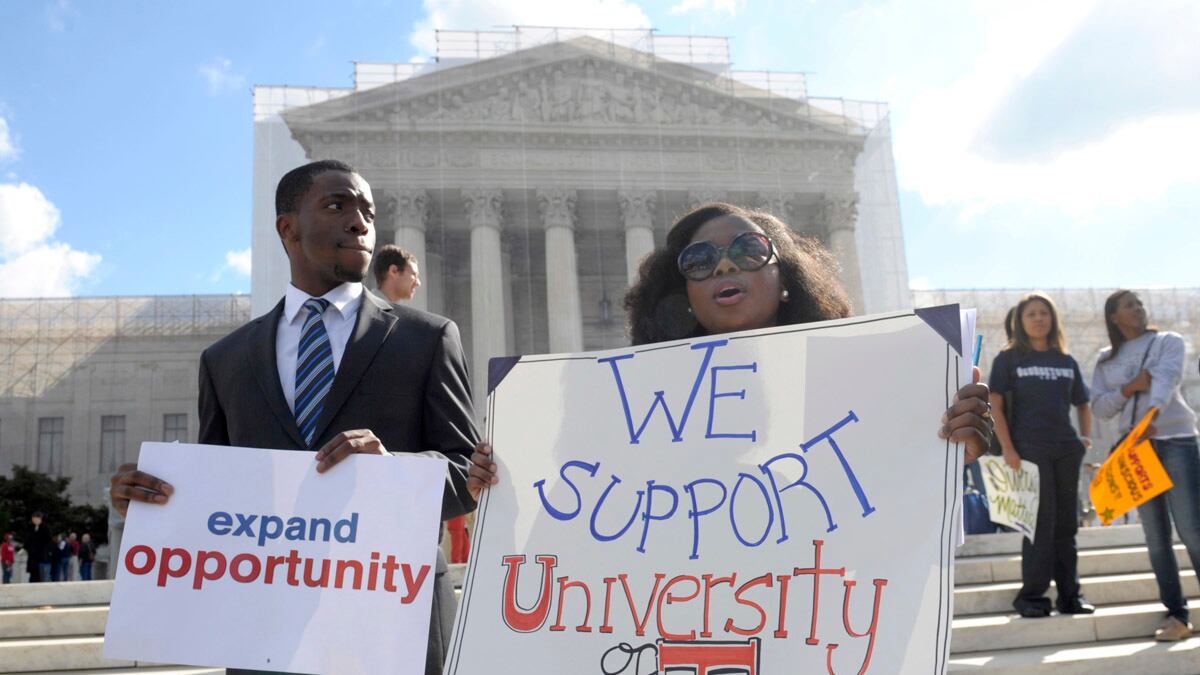The Supreme Court heard arguments Wednesday (PDF) in a potentially landmark case that could spell the end of race-based affirmative action in higher education. The case involves a challenge to the University of Texas’s admissions policy that makes race one relevant factor—along with the usual assortment of other criteria, like SAT score, grade-point average, being a legacy, and skills such as playing football or the tuba. Abigail Fisher, a white applicant who was denied admission, claims that UT’s policy violates the 14th Amendment, which guarantees the “equal protection of the laws.”

Judging from the justices’ comments at oral arguments—which, lest we forget, can be misleading—her prospects of winning look quite good.
Although the Supreme Court upheld the use of race as an admissions factor less than a decade ago, the current conservatives on the court were dismissive of the rationale used in that case. Chief Justice John Roberts suggested UT’s effort to seek a “critical mass” of minority students was unworkable; Justice Antonin Scalia said Fisher “was not treated fairly”; and Justice Samuel Alito suggested that UT’s policy privileges successful minorities over the interests of whites “whose parents are absolutely average in terms of education and income.”
Perhaps surprisingly, the one thing missing from today’s oral argument was history. Justices Scalia and Clarence Thomas—both hostile to affirmative action—claim to be constitutional originalists. In other words, they say the Constitution in 2012 should be read to mean precisely what (we presume) the Framers meant in 1787, give or take a few decades.
But the irony is that the authors of the 14th Amendment believed that race-based affirmative action was entirely consistent with that provision. As their rulings on affirmative action show, Scalia and Thomas love history—but only when it suits them.
The 14th Amendment was adopted right after the Civil War as a way of insuring that the rights of the freedmen would not be denied by the Southern states. While the amendment’s language is broad, it was not thought at the time to outlaw any and all uses of race by the government. In fact, the same men who drafted and ratified the 14th Amendment enacted a variety of laws intended to achieve, in the words of one congressman at the time, “the amelioration of the condition of the colored people.”
Some of these laws are well known, such as the Freedmen’s Bureau Acts, which established a federal agency to assist the freedmen secure housing, food, education, and education. But like today’s affirmative-action policies, these laws were opposed by some on the grounds that they used race (or some equivalent proxy) to dole out benefits. West Virginia Sen. Waitman Willey criticized the Freedmen’s Bureau Act because it made “a distinction on account of color between the two races.” One congressman insisted the Freedmen’s Bureau was “in opposition to the plain spirit” of the Constitution, which required that “congressional legislation should in its operation affect all alike.”
These men thought that the Constitution should be completely colorblind. Today, that view is represented best perhaps by Chief Justice John Roberts, who wrote in a 2007 school integration case “The way to stop discrimination on the basis of race is to stop discriminating on the basis of race.”
Roberts’s line was pithy, but also far removed from the original meaning of the 14th Amendment. In fact, time after time, the framers of that amendment rejected the idea that laws intended to help historically oppressed racial minorities had to be racially neutral.
In addition to the Freedmen’s Bureau laws, Congress passed race-conscious laws designed to help secure enlistment bounties for “colored soldiers” who served in the Union Army and to provide for “the relief of destitute colored women and children.” The next year, a separate poverty bill was enacted for “colored” people of the District of Columbia.
No objective was more important to the framers of the 14th Amendment than improving access to education by racial minorities. Within a few years of establishment of the Freedmen’s Bureau, the federal agency had created nearly 3,000 schools serving more than 150,000 students. Many of today’s legendary black schools, like Howard University, can trace their origins to these post–Civil War efforts to integrate and educate African-Americans.
And yet it looks like a case about affirmative action in education may well be the downfall of all race-conscious government policies.
So how do justices like Scalia and Thomas, who purport to be governed by historical understanding of the Constitution, square these laws with their consistent votes to overturn race-based affirmative action? They don't. Instead, they ignore this history entirely.
Scalia sometimes says that he’ll break from history where there’s a long line of Supreme Court cases that have settled expectations about the law. In the affirmative-action context, however, the court has repeatedly upheld the ability of colleges and universities to use race as one factor in admissions. The most recent case clearly holding that—Grutter v. Bollinger—was decided less than a decade ago. Yet no Supreme Court expert expects Scalia to respect that established tradition.
Perhaps the lesson of the affirmative-action cases is that Justices Scalia and Thomas are originalists only when history and tradition match their preconceived notions of right and wrong.




